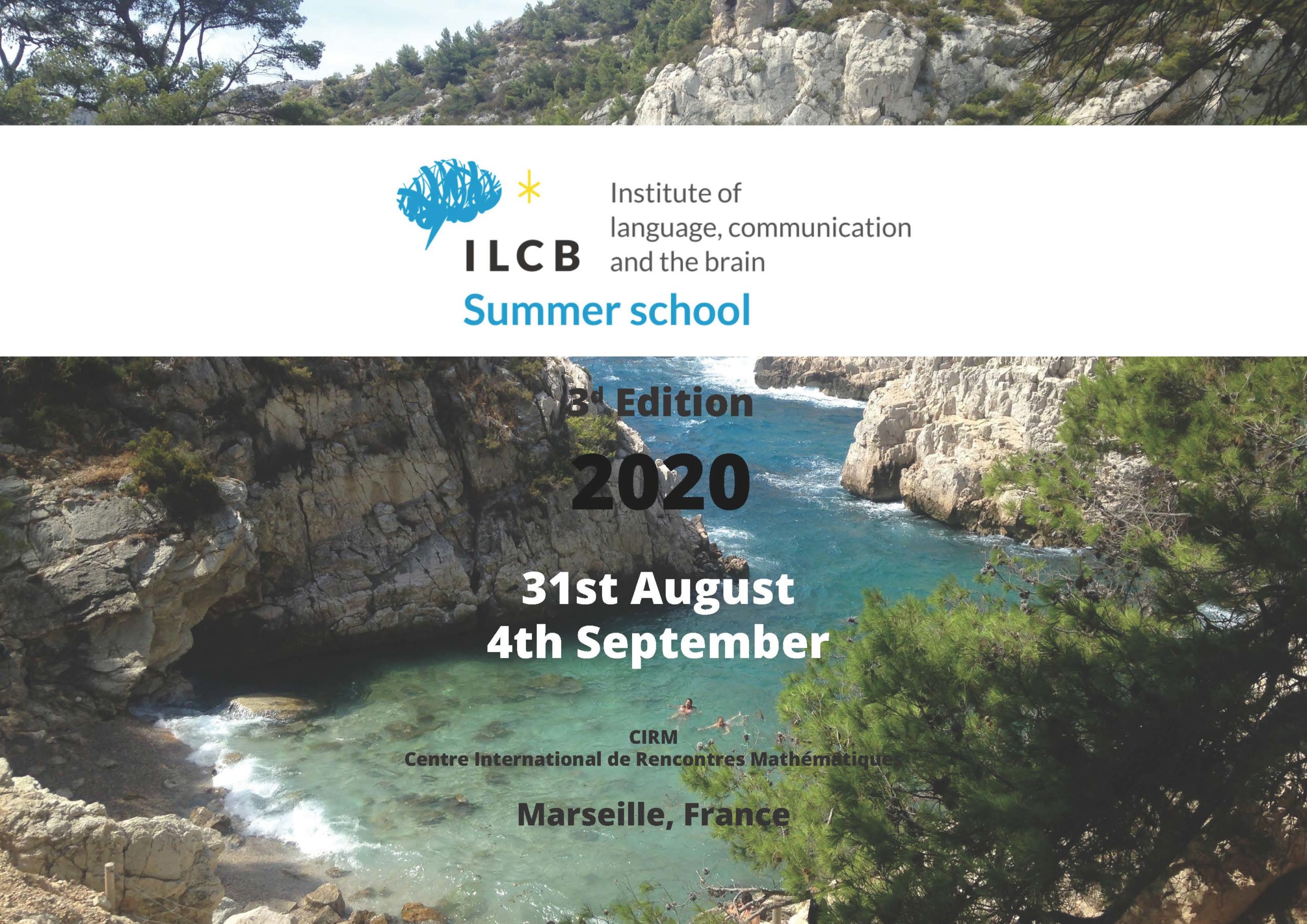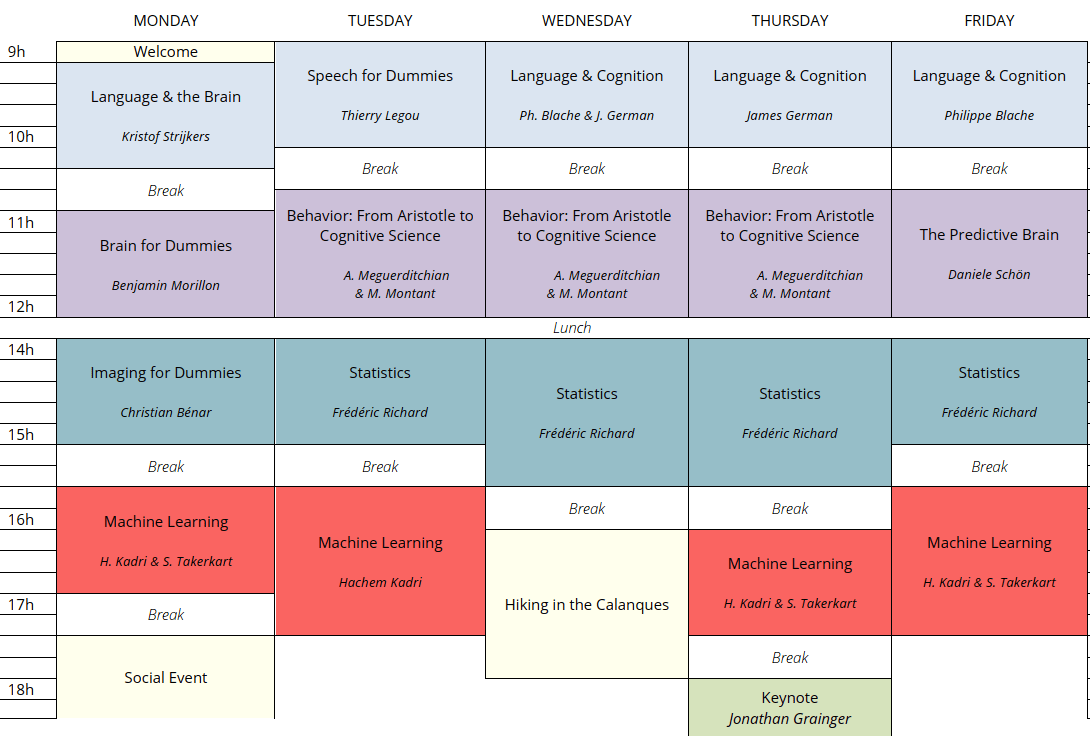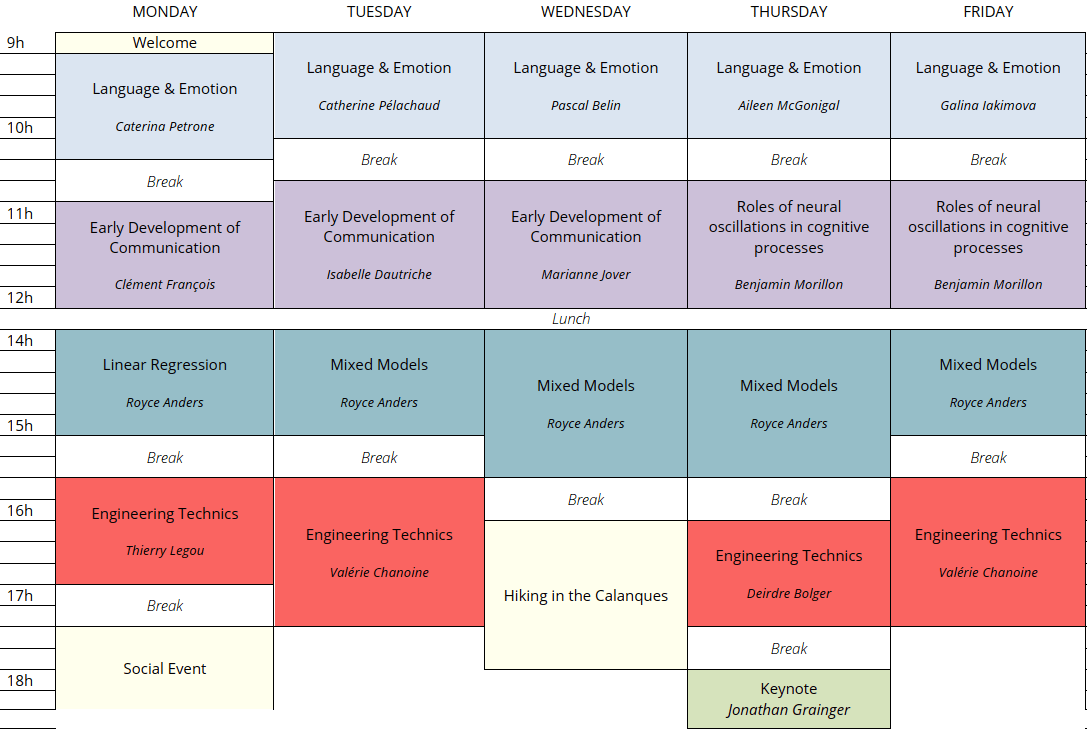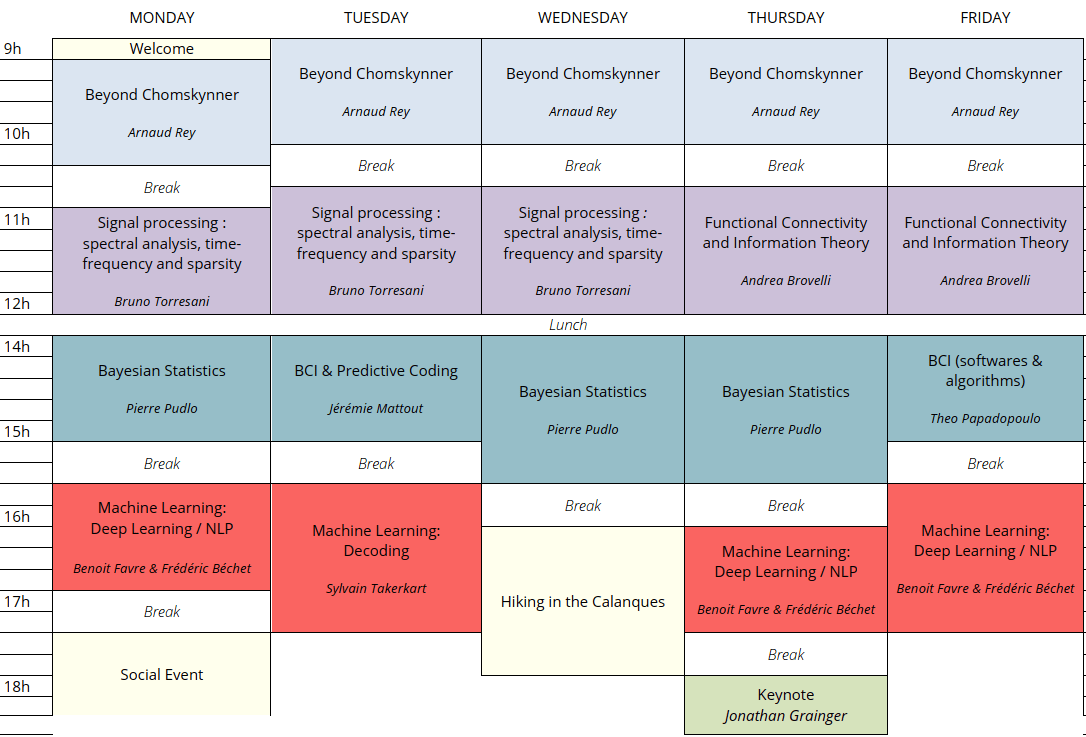3d_ILCB_SummerSchool_DetailedProgram

Click here to access the talks.
The 3d Edition of the ILCB Summer School offers Introductory, Intermerdiate and Advanced Classes in four core fields of Cognitive Science, reflecting the expertise of the Institute:
• Applied mathematics, statistics and networks
• Neuroscience and behavior;
• Language and cognition;
• Computer science and machine learning
Keynotes and social events complete this week of immersion.
KEYNOTE: Prof. Jonathan GRAINGER
Fees:
- ILCB Members: Free (please, contact the administration for detail of accomodation)
- Non-ILCB Members: 105€ /day/per for Full Board (including accomodation, meals and participation to social events)
Download detailed program 3d_ILCB_SummerSchool_DetailedProgram a PDF
Basic Courses
Intermediate Courses
Advanced Courses
SYLLABUSES
Basic Courses
Language & the Brain, K. Strijkers
Speech for Dummies: Th. Legou
Language & Cognition, J. German & Ph. Blache
Language is made of different components at different levels: sounds (or letters), words, groups, sentences, utterances (or texts). It is usually considered that human language relies on this ability to combine low-level units into larger ones in order to build meaning. Understanding how language works consists then in describing these different levels through their corresponding linguistic domains (phonetics, prosody, phonology, morphology, syntax, semantics) and to explain how do they interact. We propose in this course an overview of these domains and present the different theories explaining how meaning can be built from them.
Brain for Dummies, B. Morillon
This course will provide a general overview of the human brain, mainly through a historical, theoretical, and structural viewpoint.
Behavior: From Aristotle to Cognitive Science, A. Meguerditchian & M. Montant
This course proposes an introduction to human and non-human animal behavior in relation to language studies and the question of the phylogenetic origins of the language faculty. The course is organized in two parts. In the first part, Adrien Meguerditchian will make a brief historical overview of how behavior is assessed over times, from Aristotle to Darwin, then he will describe the concepts and methods proposed by the behaviorist paradigm, the biology of behavior and the contemporary cognitive ethology. During the second part, Marie Montant will address several questions raised by the comparison between human and non-human animals. Then she will describe the relationship between the complexity of behaviors and brain evolution, and how human behaviors are measured in cognitive paradigms.
The Predictive Brain, D. Schön
Schön will give a lecture about the predictive brain : How do we perceive the world surrounding us? What is the role of memory? How many real worlds exist? To what extent our knowledge limits how we study brain functions? I will try to address these and other questions by adopting a musical view of brain functions.
Imaging for Dummies, C.-G. Benar
In this course, I will provide an overview of functional brain imaging in humans. Specifically, I will present three modalities: functional MRI, electroencephalography (EEG), magnetoencephalography (MEG), and intracerebral EEG (this latter being performed in patients during presurgical evaluation of epilepsy). For each modality, I will review briefly the underlying mechanisms, the recording technique and the mathematical tools for data analysis.
Statistics:
This course is an introduction to statistical inference aimed at familiarizing participants with estimation and testing issues. After having presented some useful notions on random variables, we will first see how to estimate and test the mean value (expectation) of samples of random variables of unknown distribution. During two practical sessions carried out in Python, we will then study in details the case of samples of Bernoulli’s law. Finally, in a last part, we will approach the inference problems in the framework of Gaussian samples.
Machine Learning, H. Kadri
This course aims to provide an overview of problem solving and data modeling from a machine learning perspective. The concepts of data representation, distribution, statistics as well as training, validation and testing will be reviewed, as well as the details of some learning algorithms. Practical work will be performed on a concrete problem with standard tools, which will allow to see the basic concepts of programming in Python.
INTERMEDIATE COURSES
Language & Emotion, P. Belin, G. Iakimova, A. McGonigal, C. Petrone, C. Pélachaud
- The lecture of P. Belin will be dedicated to investigating how the brain processes information in voice, including emotions.
- With C. Pélachaud class, we will present computational methods to model socio-emotional behaviors for virtual agent, focusing on communicative acts, emotions, and social attitudes. We will cover the relation between mental states and nonverbal behaviors as well as their realization in an embodied conversational agent.
- After reviewing basic notions concerning prosody (ie., the rhythmical and melodic organization of speech), Caterina Petrone will provide an overview of major findings on emotional prosody and their theoretical implications from a linguistic perspective. Issues for future research will be also discussed.
- McGonigal will give a lecture about Emotions and frontal lobe seizures.
Early Development of Communication, I. Dautriche, C. François, M. Jover
- Clément François se focalisera sur le développement neuroanatomique des réseaux de langage ainsi que sur les phénomènes de neuroplasticité sous-tendant le développement précoce de la perception de la parole avec un focus sur le raffinement phonologique. Pour se faire, il présentera les résultats d’études comportementales et de neuroimagerie menées chez le nourrisson et le tout petit.
- Isabelle Dautriche’s lecture will concern word learning. Word learning is often considered the simplest and least controversial aspect of language development. Although theorists fiercely debate the ontogenetic and phylogenetic origins of grammar, everyone agrees that words must be learned by observing the contexts in which they are used. No other theory can explain how English-speaking children come to use ‘shoe’ to label footwear, whereas young French speakers use the same sequence of sounds to label cabbage. However, this self-evident truth masks a host of questions about how learning occurs and the knowledge that children bring to the problem. In this class, I will provide an overview of what we know about word learning in the very first years of life.
- From a developmental point of view, it is unlikely that intentional communication appears from scratch at the end of the first year (Ramenzoni & Liszkowski, 2016). Presenting her current researches, Marianne Jover will focus on the early development of communicative gesture and adults’ understanding of the infants’ movements (Jover & Scola, 2018, Jover et al., 2019).
Roles of neural oscillations in cognitive processes, B. Morillon
These two courses will introduce the main mechanistic functions for which neural oscillations are believed to play a role in information processing: synchronisation of local and large-scale neural ensembles, inter-areal communication-through-coherence, and segmentation of continuous sensory information into discrete computational units. We will review different cognitive functions for which these mechanisms apply, such as spatial and temporal attention, and most importantly speech, language and communication.
Linear Regression & Mixed Models, R. Anders
This course will provide both the theoretical background and skills to apply regression/mixed models in R/RStudio. Mixed models are some of the most popular analytical approaches in the human sciences, and the R programming language is widely used in academia. Topics include (but are not limited to) loading and assessing the integrity of your data set (missing values, outliers, etc.), distributional analysis and visualisation, mathematical understanding and requirements for an appropriate regression/mixed model, data transformations, model application, model checks and optimization, model selection, and if time permits, generalized linear mixed models such as with the logit family.
Engineering Technics: Th. Legou, V. Chanoine, D. Bolger
- Session “Physics and acoustic aspects of the speech production” (Th. Legou)
Speaking is a complex activity that implies numerous high level and low level controls. While speech permits to communicate, producing various identified class of sounds, voice convey information about certain characteristics of the locutor itself and about its inner state.
We will first look at the vocal tract, identifying the main actuators/contributors (as well as their physic, mechanic and acoustic properties) that lead to the production of various sounds which, when combined, permit the speech production.
We will talk about vowels and consonants specificities, presenting rapidly the main classical signal processing to study and characterize them.
Online demos will permit to better understand acoustic properties of sounds produced, as well as the signal processing used to study these sounds.
ADVANCED COURSES
Beyond Chomskynner, A. Rey
In 1957, the publication of Syntactic structures by N. Chomsky and Verbal Behavior by B. F. Skinner introduced two radically different approaches to the study of language. After a brief and critical presentation of these approaches, I will pave the way to current approaches based on language use and implicit statistical learning, showing that these approaches have slowly created a favorable climate for a paradigm shift in the study of language processes. I will also argue that the central notion of syntax should certainly be reconsidered or eventually, abandoned.
Signal processing : spectral analysis, time-frequency and sparsity, B. Torresani
- Lecture 1 : Spectral analysis and time-frequency
The focus in this first lecture will be on signal analysis. We will review reference methods for spectral analysis (Fourier transform, periodogram), and time-frequency analysis (short time Fourier transform and periodogram, Gabor transform,…). If possible we will also briefly discuss iterated filter banks (convolution networks and scattering transform)
- Lecture 2 : Time-frequency and wavelets, synthesis
In the second lecture we will revisit time-frequency methods from the point of view of synthesis rather than analysis. We will describe the basics of frame theory, discrete transforms and the construction of linear systems defined in the time-frequency domain.
- Lecture 3 : Sparse time-frequency representations
The last lecture will be devoted to the concept of sparsity, and will focus on standard algorithms for constructing sparse time-frequency and wavelet representations.
Functional Connectivity and Information Theory, A. Brovelli
I will present an overview of the mathematival and computational tools for the analysis of functional connectivity (FC) among neural signals. I will introduce notions such as non-directed versus directed (e.g., Granger causality) FC, time- versus frequency-domain FC measures. Finally, I will present recent advanced in Information Theory that allow the characterisation of task-related neural interactions.
Bayesian Statistics: TBA
BCI & Predictive Coding: TBA
BCI (softwares & algorithms) : TBA
Machine Learning: Deep Learning / NLP: TBA
Machine Learning: Decoding: TBA
KEYNOTE LECTURE
PARALLEL ORTHOGRAPHIC PROCESSING AND READING
Pr. Jonathan Grainger
In written languages that use an alphabetic script, orthographic processing lies at the heart of the reading process, enabling visual information to make contact with linguistic information. Indeed, reading can be viewed as a bi-directional interaction between the processing of visual and linguistic information, with orthographic processing serving as the crucial interface between the two. In the present talk, I will summarize the knowledge that has accrued concerning orthographic processing in single word reading before presenting more recent research on sentence reading and the processing of orthographic information spanning several words. In both lines of research, the key words are: parallel, cascaded, and interactive processing. For single word reading the interactivity involves position-coded letter identities and whole-word orthographic representations, and for sentence reading it extends to involve ordered word identities and higher-level sentence structures.
This talk will be followed by a Lunch and a Concert! Registration is free but mandatory. Please confirm attendance by sending an email to nadera.bureau@blri.fr



